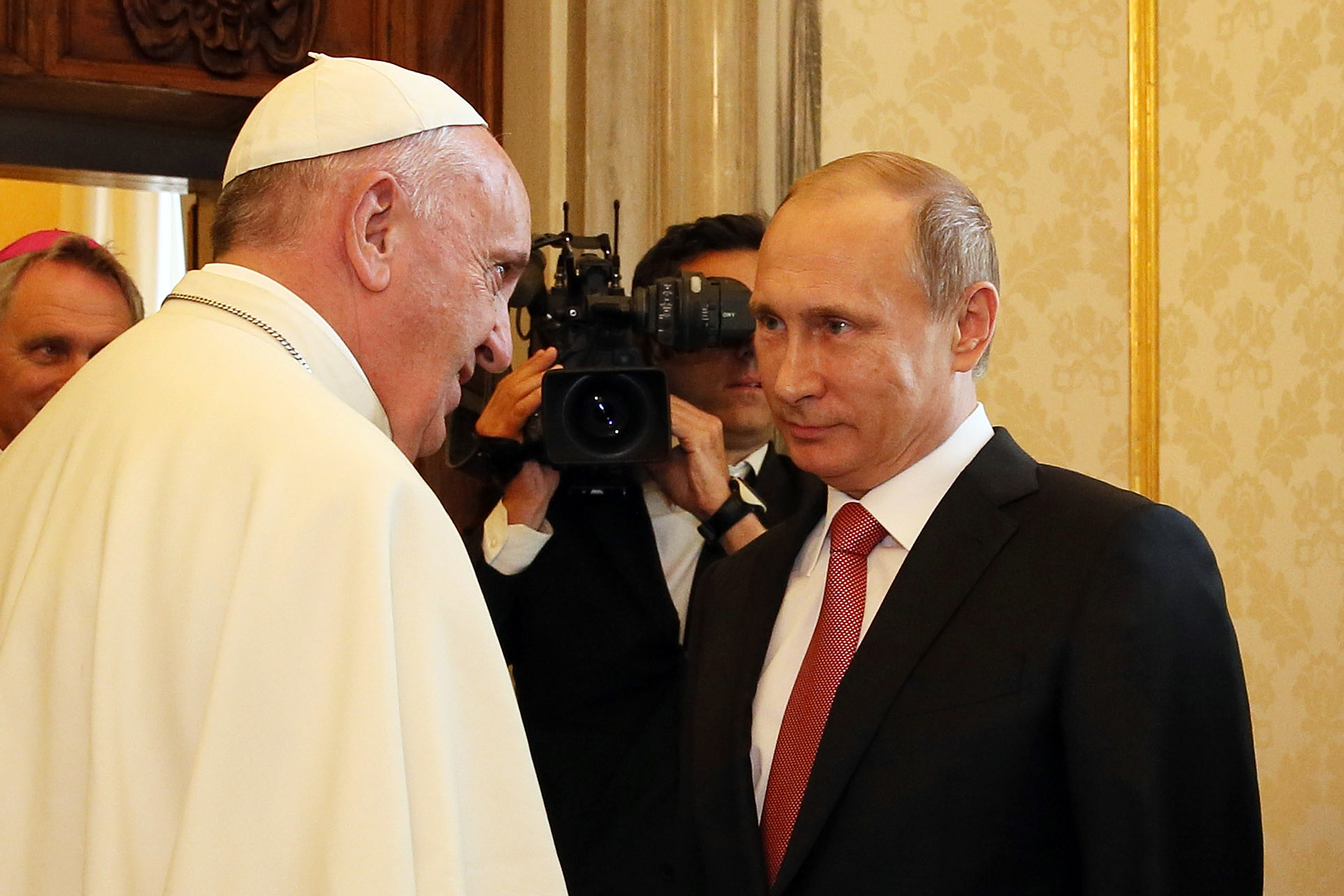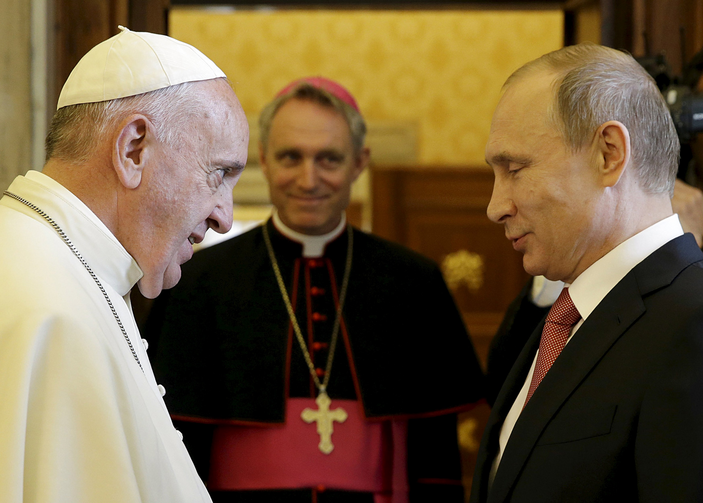When you hear the names Vladimir Putin and Pope Francis in the same sentence, it's hard not to be intrigued. These two global figures represent vastly different worlds—political power and spiritual leadership—but their interactions have sparked conversations worldwide. The relationship between Putin and Pope Francis is a fascinating blend of diplomacy, faith, and politics, and it’s something that has captured the attention of millions. Let’s dive into this unique dynamic and explore what it means for both Russia and the Vatican.
Now, before we get too deep into the details, let's set the stage. Vladimir Putin is more than just the President of Russia; he's a figure who commands respect—or controversy—depending on who you ask. On the other side, Pope Francis isn't just the leader of the Catholic Church; he's a symbol of hope and reform for millions around the globe. Their meeting points might seem unlikely, but they exist, and they’re worth exploring.
So, why does this matter? Because their interactions reflect broader themes of global diplomacy, religious influence, and the delicate balance between political power and moral authority. This isn't just about two leaders—it's about the world they represent and how their actions ripple through international relations. Let’s break it down.
Read also:Kim Blocks Norths Visit To Kanye The Inside Story You Need To Know
Understanding the Background: Who Are These Figures?
First things first, let’s get to know our main players a little better. Vladimir Putin has been at the helm of Russia for over two decades, and his leadership style is as complex as it is polarizing. He's often described as a strongman who prioritizes national sovereignty and traditional values. Meanwhile, Pope Francis brings a completely different energy to the table. As the first pope from the Americas, he's known for his progressive stances on social issues and his commitment to bridging divides across faiths and nations.
Biography of Vladimir Putin
Before we dive deeper, here’s a quick rundown of Putin's life:
| Full Name | Vladimir Vladimirovich Putin |
|---|---|
| Birth Date | October 7, 1952 |
| Birth Place | Leningrad, Soviet Union (now St. Petersburg, Russia) |
| Profession | President of Russia |
| Political Party | United Russia |
Putin started his career in intelligence with the KGB before transitioning into politics. His rise to power has been marked by strategic moves and a focus on consolidating authority within Russia.
Biography of Pope Francis
Now, let’s talk about Pope Francis:
| Full Name | Jorge Mario Bergoglio |
|---|---|
| Birth Date | December 17, 1936 |
| Birth Place | Buenos Aires, Argentina |
| Profession | Pope of the Roman Catholic Church |
| Papacy Began | March 13, 2013 |
Pope Francis is known for his humility and focus on social justice. He’s often seen as a reformer within the Catholic Church, pushing for changes that reflect modern realities.
Their First Encounter: A Meeting of Minds?
The first official meeting between Putin and Pope Francis took place back in 2013, shortly after Francis became pope. This encounter was rich with symbolism. While the Vatican and Russia have had a complicated history, this meeting suggested a new chapter of cooperation. Both leaders discussed issues like religious freedom and the situation in Syria, which was embroiled in conflict at the time.
Read also:Delta Plane Crash Shocking Video Emerges
What made this meeting significant? Well, it wasn’t just about exchanging pleasantries. It was about laying the groundwork for future collaboration on global issues. And let’s be honest, seeing Putin in the Vatican feels like something out of a political thriller, but it’s real, and it matters.
What Did They Talk About?
Here’s a quick list of topics that were likely on the table:
- Religious freedom in Russia and beyond
- The humanitarian crisis in Syria
- Ecumenical relations between the Catholic and Orthodox Churches
- Global peace initiatives
While the exact details of their discussions remain private, these topics align with the priorities of both leaders.
Global Diplomacy: How Their Relationship Shapes International Relations
Now, here’s where it gets interesting. The relationship between Putin and Pope Francis isn’t just about personal connections—it’s about how their interactions influence global diplomacy. When two such powerful figures come together, it sends a message. It suggests that even in a world filled with division, there’s room for dialogue and cooperation.
For example, during the ongoing conflicts in Ukraine and other regions, both leaders have called for peace and reconciliation. While their approaches may differ, their shared goal of reducing suffering resonates with many. This kind of collaboration isn’t always easy, but it’s necessary in today’s interconnected world.
Challenges in Their Relationship
Of course, no relationship is perfect, especially when it involves political and religious leaders. One of the biggest challenges is the historical tension between the Catholic Church and the Russian Orthodox Church. Despite Pope Francis’s efforts to bridge this gap, old wounds don’t heal overnight.
Additionally, there are concerns about human rights and religious freedom in Russia. Pope Francis has spoken out on these issues, which sometimes puts him at odds with Putin’s administration. It’s a delicate balance, but one that both leaders seem willing to navigate.
Religious Influence: The Role of Faith in Politics
Let’s talk about faith for a moment. For Pope Francis, faith is more than just belief—it’s action. He uses his position to advocate for the marginalized and push for systemic change. Putin, on the other hand, often aligns himself with the Russian Orthodox Church, which plays a significant role in Russian culture and politics.
This intersection of faith and politics is fascinating. It shows how religious leaders can influence political decisions and vice versa. Whether it’s through public statements, private meetings, or symbolic gestures, both Putin and Pope Francis use their platforms to shape the world around them.
How Faith Guides Their Actions
Here are some ways faith influences their leadership:
- Pope Francis emphasizes compassion and inclusivity in his teachings
- Pутin often references Orthodox traditions to reinforce national identity
- Both leaders use religious language to frame their public messages
These elements add depth to their interactions and help explain why they approach certain issues the way they do.
Media Coverage: What Are They Saying?
Now, let’s talk about how the media covers this relationship. Depending on where you get your news, the narrative can vary wildly. Some outlets focus on the positive aspects of their collaboration, while others highlight the challenges and disagreements.
For instance, Western media often portrays Putin as a controversial figure, while Pope Francis is generally viewed more positively. However, in Russia, the narrative might flip, with Putin seen as a strong leader and Pope Francis as an outsider trying to influence internal affairs.
Key Media Highlights
Here are some key points from recent coverage:
- Pope Francis has called for dialogue with Russia on Ukraine
- Pутin has praised the pope’s efforts to promote peace
- Both leaders have been criticized by different factions for their stances
It’s important to consume media critically and consider multiple perspectives when evaluating their relationship.
Future Prospects: Where Do They Go From Here?
So, what does the future hold for Putin and Pope Francis? While no one can predict with certainty, there are signs that their relationship will continue to evolve. With ongoing global challenges like climate change, poverty, and conflict, both leaders have ample opportunities to work together.
One potential area of collaboration is interfaith dialogue. As the world becomes more diverse, promoting understanding between different religious traditions becomes increasingly important. Both Putin and Pope Francis have shown a willingness to engage in these conversations, which could lead to meaningful outcomes.
Possible Areas of Cooperation
Here are a few possibilities:
- Joint initiatives on humanitarian aid
- Efforts to combat climate change
- Programs to support refugees and migrants
These projects could strengthen their partnership and demonstrate the power of collaboration across ideological lines.
Public Perception: What Do People Think?
Finally, let’s touch on public perception. How do ordinary people view the relationship between Putin and Pope Francis? It varies widely depending on cultural, political, and religious backgrounds. Some see it as a hopeful sign of unity, while others remain skeptical.
What’s clear is that their interactions capture the imagination of people worldwide. Whether it’s through social media, news articles, or personal discussions, this relationship sparks conversation and reflection.
Common Public Reactions
Here’s a snapshot of what people are saying:
- “It’s inspiring to see leaders from different worlds coming together.”
- “I’m skeptical about how much they can actually achieve together.”
- “Their relationship highlights the complexity of global diplomacy.”
These varied responses reflect the broader complexities of international relations.
Conclusion: The Power of Dialogue
In conclusion, the relationship between Putin and Pope Francis is a testament to the power of dialogue. While they come from different worlds, their interactions remind us that collaboration is possible, even in the face of significant differences. By working together, they can tackle some of the world’s most pressing issues and inspire others to do the same.
So, what can you do? Share this article with friends and family to spark conversations about global diplomacy and interfaith relations. Leave a comment below with your thoughts on their relationship. And don’t forget to explore more content on our site for insights into other fascinating topics!
Table of Contents
Understanding the Background: Who Are These Figures?
Their First Encounter: A Meeting of Minds?
Global Diplomacy: How Their Relationship Shapes International Relations
Religious Influence: The Role of Faith in Politics
Media Coverage: What Are They Saying?
Future Prospects: Where Do They Go From Here?
Public Perception: What Do People Think?
Conclusion: The Power of Dialogue


